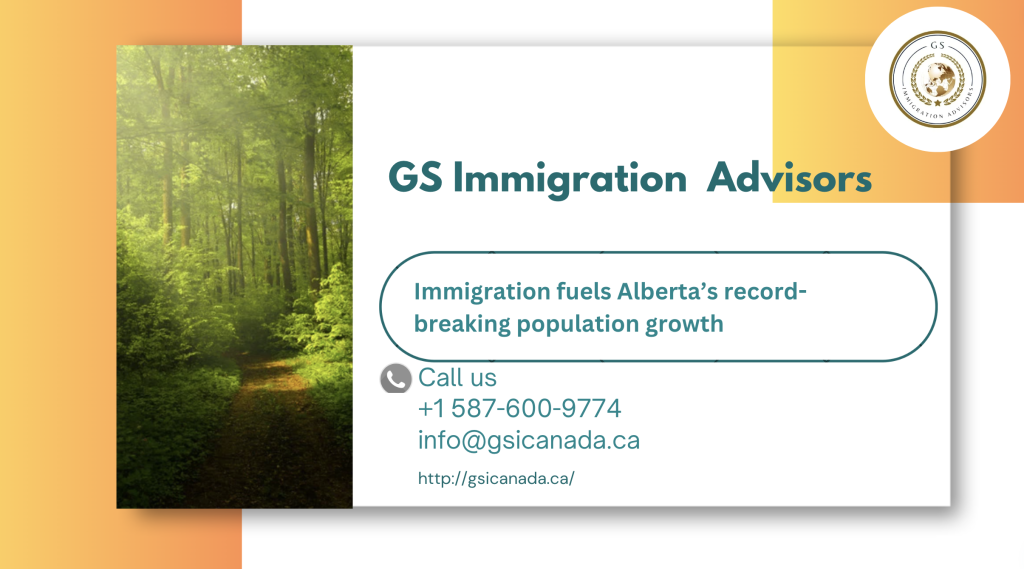
Alberta has been seeing population growth that breaks records. The province of Alberta has experienced exponential increase in both interprovincial and international immigration, according to recent data from the government’s Office of Statistics and Information.
The population of the province increased by 204,677, or 4.41%, between April 2023 and April 24. This represents the largest year-over-year growth rate in 2023–24 among all Canadian provinces. For the entire country of Canada, the yearly growth rate during the same period was 3.20%.
It shows a significant increase from the 3.67% growth rate Alberta experienced between 2022-23 and is also the highest year-over-year growth the province has experienced as of April 1 since 1981.
Much of Alberta’s population growth comes from international migration. In the first quarter of 2024 alone, international migration added 32,893 net new residents to Alberta. This includes both permanent, and temporary residents (those holding work or study permits or asylum claimants).
Alberta is also seeing strong net gains from interprovincial migration—people moving from other Canadian provinces such as Ontario, BC, Saskatchewan, Nova Scotia, and Manitoba.
According to Statistics Canada, from July 1, 2022, to July 1, 2023, Alberta saw the highest net gains from people moving between provinces, surpassing British Columbia. All four major cities in Alberta grew significantly: Calgary gained 26,662 residents, Edmonton added 16,082, Lethbridge increased by 1,651, and Red Deer grew by 1,277 people.
In contrast, every major metropolitan area in Ontario saw a net loss from interprovincial migration during the 12 months leading up to July 1, 2023.
Why are so many newcomers choosing Alberta over other Canadian provinces?
As Statistics Canada points out, this influx is “in-line with the analysis from the Canada Mortgage and Housing Corporation’s 2024 Housing Market Outlook” which indicates that more affordable home prices and a stronger economic outlook make the prairie provinces attractive to job seekers and home buyers – especially when compared to British Columbia and Ontario.
Relatively affordable housing
While the province has seen an increase in property prices in recent years, it is still seen as a more affordable option, especially when compared to cities in Ontario and B.C.
According to the Canadian Real Estate Association (CREA), in the second quarter of 2024, the median price for a single detached home in Calgary was $710,000, while townhouses cost $454,000, and apartments $330,000. In Edmonton (the second largest census metropolitan area in Alberta), the median price for a detached home was $485,000, townhouses were $294,500, and apartments were $188,000.
Additionally, Alberta does not have land transfer tax, making it a more affordable option for out-of-province homebuyers.
In comparison to Toronto (Ontario), the median sale price for a detached home was $1,300,000 in the second quarter of 2024. Semi-detached units were going for $1,041,000 while condominium apartments were going for $640,000.
Economic growth and changing job landscape
Alberta’s real gross domestic product (GDP) is expected to rise 3.3% in 2024, up 0.4 percentage points from Budget 2024.
According to the Business Council of Alberta’s report “Who’s Hiring in Alberta?” which uses publicly available job postings from 2018-23, Alberta’s labour market is no longer closely attached to the price of oil and gas, as was the case in previous years.
While demand for energy workers has “stabilized,” there has been increase in demand for trades and healthcare occupations which has “far outpaced population growth.”
The report also notes growth in job postings requiring a collage diploma or apprenticeship training. Tech skills such as business intelligence or data analysis may also be important to employers in the province. Meanwhile, postings for categories of engineering occupations fell more than 60%.
The province introduced a distinct PNP stream for tourism and hospitality earlier this year, a sign of growing demand in that industry.
The government has also directed its Express Entry lotteries toward healthcare professionals. If a candidate has a job offer in one of the province’s qualified health care occupations, they may be eligible for permanent residence in Alberta under the Alberta Advantage Immigration Program (AAIP) Dedicated Healthcare Pathway.
